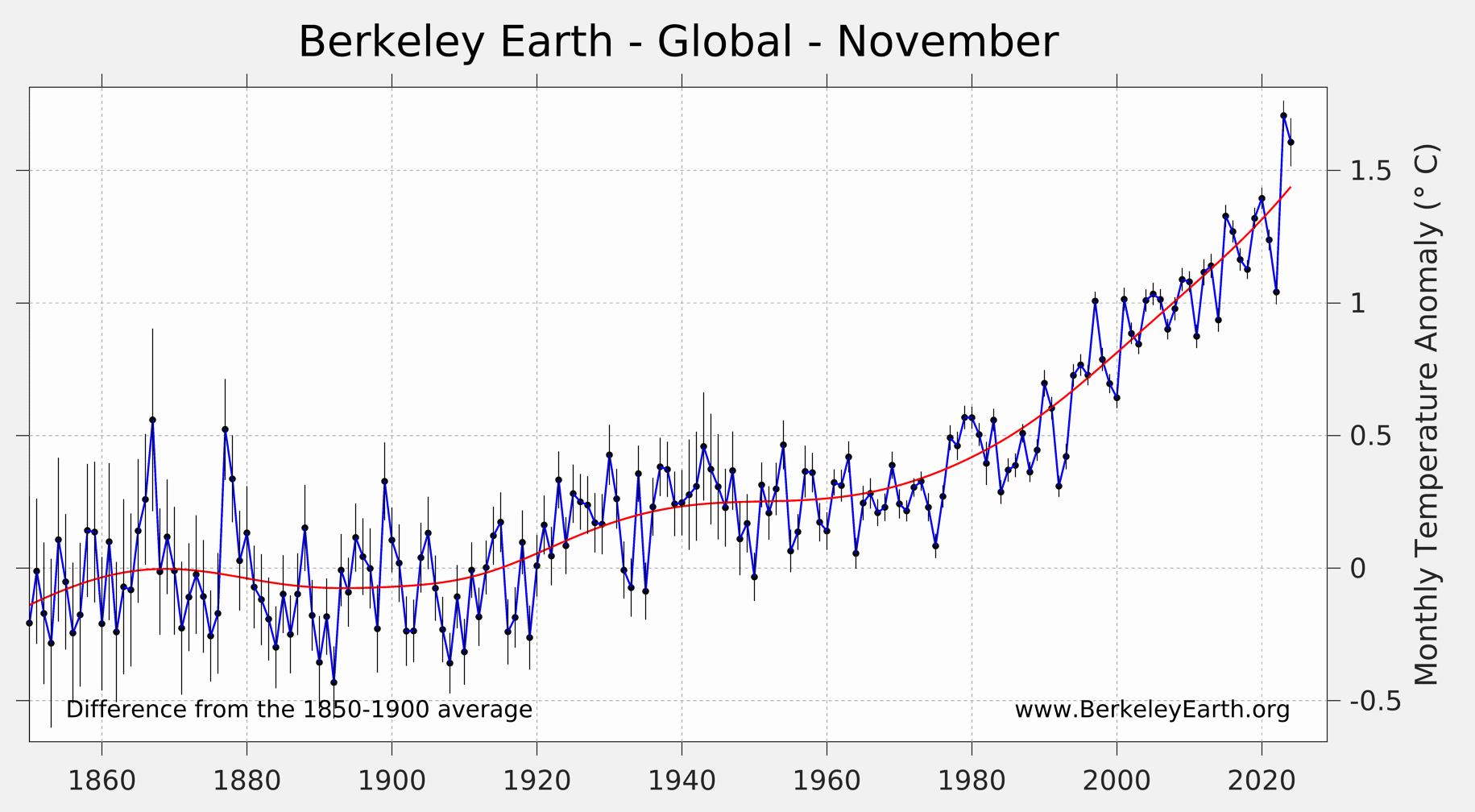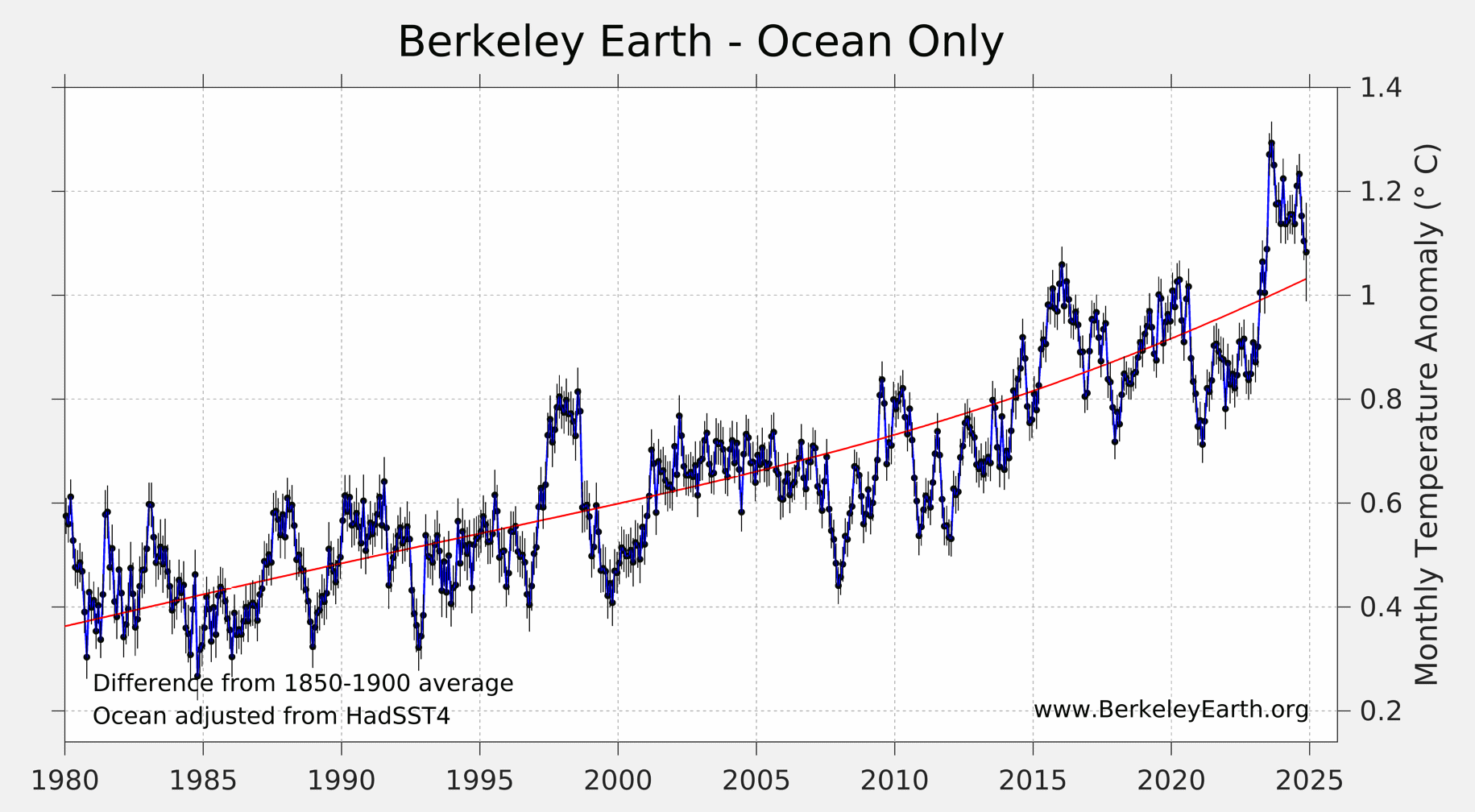The assessment report 'State of the Climate 2024' released by the World Meteorological Organization (WMO) gives essential clues to global climate trends. This report highlights major changes in greenhouse gas concentrations and the rise of temperatures. According to the report, we also see shrinking of large ice coverage in poles, melting glaciers and increasing sea levels.
In this latest quarterly state of the climate assessment, Carbon Brief has analysed records from five different research groups that report global surface temperature records: NASA’s GISTEMP; NOAA’s GlobalTemp; Hadley/UEA’s HadCRUT5; Berkeley Earth; and Copernicus/ECMWF.

Rising Global Temperatures
From January to September 2024, global surface temperatures were 1.54 ± 0.13°C higher than the pre-industrial average. A strong El Niño event, which emerged after a prolonged La Niña phase, amplified global temperatures. This has made 2023 and 2024 the two hottest years on record, with 2024 set to take the top spot. Alarmingly, the past decade (2015–2024) is now confirmed as the warmest in the last 175 years.

Globally, November 2024 was the second warmest November since directly measured instrumental records began in 1850. November 2024 was measured as 1.61 ± 0.11 °C (2.89 ± 0.19 °F) above the corresponding 1850-1900 average. This is 0.1 °C (0.18 °F) cooler than the November 2023 record. All other November averages prior to 2023 have been at least 0.2 °C (0.36 °F) cooler than November 2024.
Greenhouse Gases Reach Record Levels

While human emissions of CO₂ and greenhouse gases continued to climb in 2024, fossil fuel emissions remain the primary driver for these increases. Some key contributors to rise in greenhouse gases include:
- Carbon dioxide (CO₂): Levels increased from 278 ppm in 1750 to 420 ppm in 2023, marking a 51% rise.
- Methane (CH₄): Concentrations surged by 165%, reaching 1934 ppb in 2023.
- Nitrous oxide (N₂O): Levels rose by 24%, reaching 336.9 ppb in 2023.
Shrinking Ice and Glaciers

Global sea ice is measured by combining both the Arctic and Antarctic regions. The data analysed by Carbon Brief in 2024 indicates below-average global sea ice extents. This shrinking ice directly contributes to rising sea levels and may disrupt ecosystems. Here are some key observations:
Arctic ice reached a minimum of 4.3 million km² in September, the seventh-lowest on record. Antarctic ice hit a minimum of 2.0 million km² in February, the second-lowest recorded. Global glaciers lost the equivalent of 1.2 meters of water in 2023—the most significant loss since 1950.
Accelerating Sea Level Rise
Ocean warming and thermal expansion leads to melting of glaciers and polar ice sheets. This indicates that the global sea levels are rising at an alarming rate. Between 2014 and 2023, the annual rise averaged to 4.77 mm, more than double the rate from 1993 to 2002.
Ocean Heat Content Hits Record Highs

Oceans absorbed an estimated 3.1 million terawatt-hours (TWh) of heat in 2023, equivalent to 18 times the world’s total energy consumption. This heat absorption causes thermal expansion and affects marine ecosystems, contributing to sea level rise. In November 2024, ocean temperatures remained elevated, though slightly cooler than October 2024. The now-dissipated El Niño and Atlantic marine heatwaves have been significant contributors to recent ocean warming.
Impact of rise in temperature on Global Water Resources
As the temperature rises, and a significant increase in heat waves across the world, many regions face extreme weather phenomenons like droughts. Mexico and central Africa face severe effects of the rise reducing crop yields. Many regions also faced extreme floods such as east Africa and parts of Brazil. This extreme flooding caused displacement and loss of lives.
Extreme Weather Events
Past few years have witnessed a significant rise in extreme Weather events. Examples include wildfires in California (USA), Australia, Greece, Siberia (Russia), and the Amazon (Brazil) or catastrophic floods in India, China, Pakistan, Bangladesh, Germany, Belgium, and parts of South America. These events cause harm to both humans and other animals, making it difficult to survive. Developed countries are generally able to deal with these events but affects poor or developing countries as they may not be able to invest rapidly in such infrastructure.
Causes of Recent Warmth
- Anthropogenic Climate Change: Human activities, primarily greenhouse gas emissions, have increased Earth’s temperature by approximately 0.19°C per decade.
- El Niño Events: The El Niño phase, which peaked in late 2023, contributed to short-term warming. Although it ended in June 2024, its residual effects persisted into November.
- Marine Heatwaves: Particularly in the Atlantic, these events further amplified warming.
Steps Toward Climate Action

Despite these challenges, many countries have Multi-Hazard early warning systems.Early warning for All (EW4All) is a ground breaking initiative aimed at ensuring every individual contributes towards protection from hazardous weather, weather or climate. South American countries and the European Union have implemented a path to transition from fossil fuels to renewable energy like nuclear, solar or wind. China, on other hand has shown an incredible adoption in transition to renewable energy while heavily invested in greener infrastructure.
FAQ Section
Why are global temperatures increasing so rapidly? Global temperatures are rising primarily due to greenhouse gas emissions from human activities, such as burning fossil fuels, deforestation, and industrial processes. Short-term phenomena like El Niño can further amplify this warming.
How does El Niño influence global temperatures? El Niño is a natural climate pattern that warms the Pacific Ocean and increases global temperatures. It often results in record-high temperature years, as seen in 2024.
Is the 1.5°C limit set by the Paris Agreement still achievable? While individual years exceeding 1.5°C don’t mean the limit is permanently breached, the current trends indicate we are approaching this threshold. Urgent emissions reductions are necessary to keep warming below this level over the long term.
What can individuals do to combat climate change?
Actions such as reducing energy consumption, supporting renewable energy, minimizing waste, and advocating for climate-friendly policies can collectively make a difference.The "State of the Climate 2024" report underscores the urgent need to address climate change. As temperatures rise and extreme events intensify, immediate action is critical to reduce greenhouse gas emissions. It also aims to adapt to changes, and build resilience. Every fraction of a degree matters in safeguarding our planet’s future.